Management Accounting: Financial Analysis and Reporting Methods
VerifiedAdded on 2023/06/17
|18
|5147
|456
Report
AI Summary
This report provides a comprehensive analysis of management accounting, exploring its essential requirements, reporting methods, and application within organizations. It delves into various management accounting systems, including inventory administration, cost accounting, and job costing, highlighting their benefits and applications. The report includes a detailed cost analysis using marginal and absorption costing techniques to prepare income statements, along with a discussion on the advantages and disadvantages of different planning tools for budgetary control. Furthermore, it examines how organizations are leveraging management accounting systems to address financial complexities and achieve sustainable success. The document concludes by emphasizing the critical role of management accounting in informed decision-making and strategic financial management. Desklib provides a platform for students to access this document and other solved assignments.
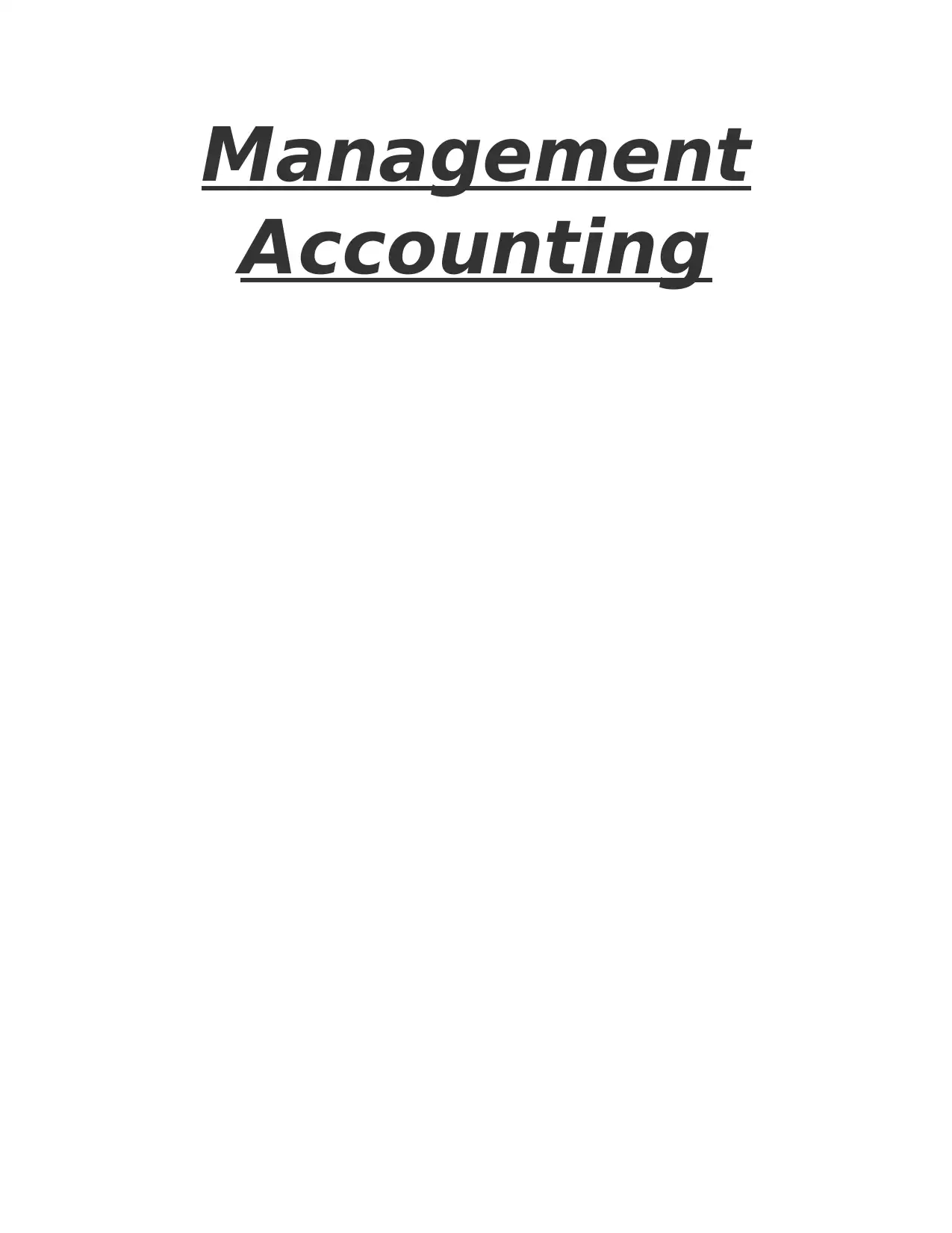
Management
Accounting
Accounting
Paraphrase This Document
Need a fresh take? Get an instant paraphrase of this document with our AI Paraphraser
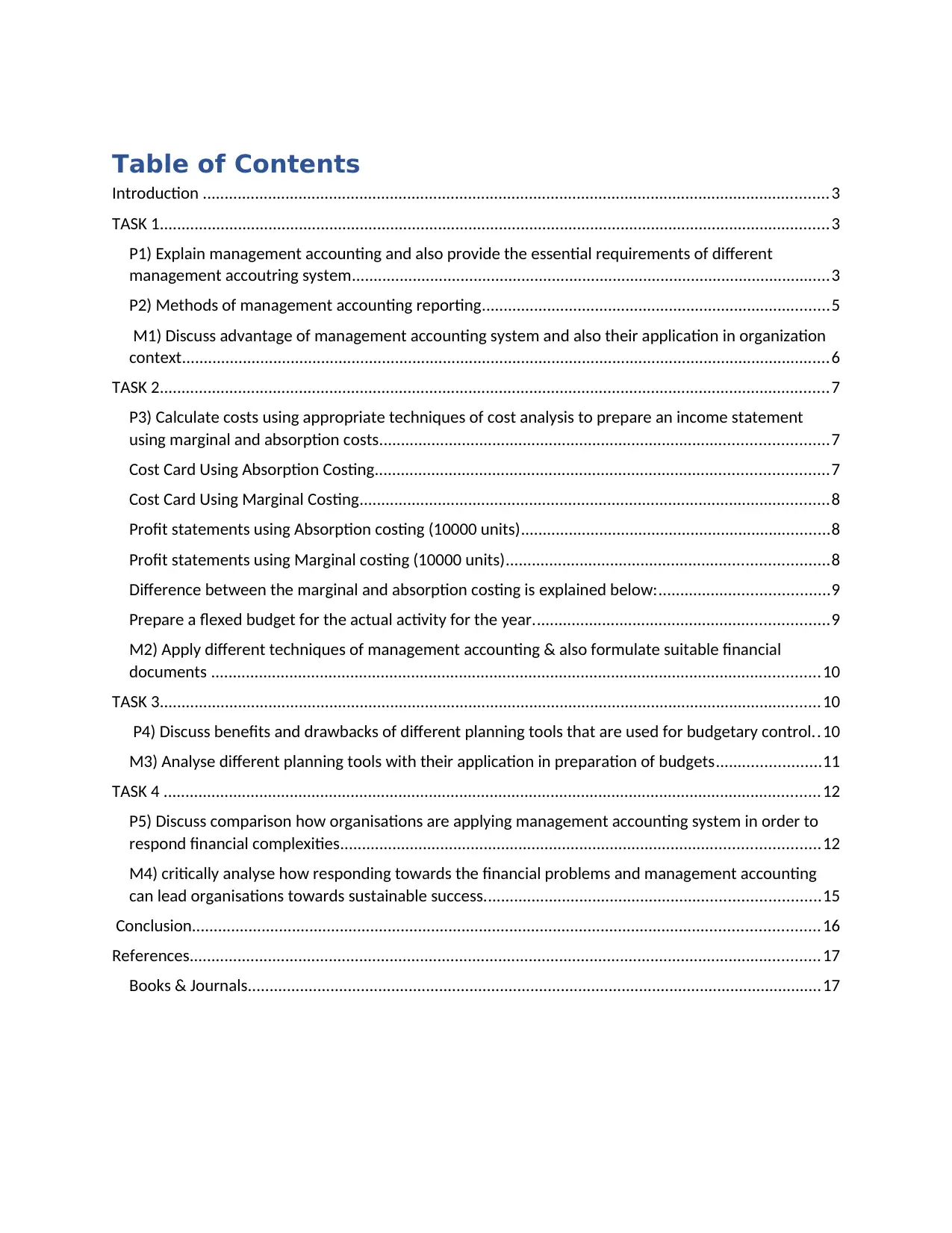
Table of Contents
Introduction ................................................................................................................................................3
TASK 1..........................................................................................................................................................3
P1) Explain management accounting and also provide the essential requirements of different
management accoutring system..............................................................................................................3
P2) Methods of management accounting reporting................................................................................5
M1) Discuss advantage of management accounting system and also their application in organization
context.....................................................................................................................................................6
TASK 2..........................................................................................................................................................7
P3) Calculate costs using appropriate techniques of cost analysis to prepare an income statement
using marginal and absorption costs.......................................................................................................7
Cost Card Using Absorption Costing........................................................................................................7
Cost Card Using Marginal Costing............................................................................................................8
Profit statements using Absorption costing (10000 units).......................................................................8
Profit statements using Marginal costing (10000 units)..........................................................................8
Difference between the marginal and absorption costing is explained below:.......................................9
Prepare a flexed budget for the actual activity for the year....................................................................9
M2) Apply different techniques of management accounting & also formulate suitable financial
documents ............................................................................................................................................10
TASK 3........................................................................................................................................................10
P4) Discuss benefits and drawbacks of different planning tools that are used for budgetary control..10
M3) Analyse different planning tools with their application in preparation of budgets........................11
TASK 4 .......................................................................................................................................................12
P5) Discuss comparison how organisations are applying management accounting system in order to
respond financial complexities..............................................................................................................12
M4) critically analyse how responding towards the financial problems and management accounting
can lead organisations towards sustainable success.............................................................................15
Conclusion................................................................................................................................................16
References.................................................................................................................................................17
Books & Journals....................................................................................................................................17
Introduction ................................................................................................................................................3
TASK 1..........................................................................................................................................................3
P1) Explain management accounting and also provide the essential requirements of different
management accoutring system..............................................................................................................3
P2) Methods of management accounting reporting................................................................................5
M1) Discuss advantage of management accounting system and also their application in organization
context.....................................................................................................................................................6
TASK 2..........................................................................................................................................................7
P3) Calculate costs using appropriate techniques of cost analysis to prepare an income statement
using marginal and absorption costs.......................................................................................................7
Cost Card Using Absorption Costing........................................................................................................7
Cost Card Using Marginal Costing............................................................................................................8
Profit statements using Absorption costing (10000 units).......................................................................8
Profit statements using Marginal costing (10000 units)..........................................................................8
Difference between the marginal and absorption costing is explained below:.......................................9
Prepare a flexed budget for the actual activity for the year....................................................................9
M2) Apply different techniques of management accounting & also formulate suitable financial
documents ............................................................................................................................................10
TASK 3........................................................................................................................................................10
P4) Discuss benefits and drawbacks of different planning tools that are used for budgetary control..10
M3) Analyse different planning tools with their application in preparation of budgets........................11
TASK 4 .......................................................................................................................................................12
P5) Discuss comparison how organisations are applying management accounting system in order to
respond financial complexities..............................................................................................................12
M4) critically analyse how responding towards the financial problems and management accounting
can lead organisations towards sustainable success.............................................................................15
Conclusion................................................................................................................................................16
References.................................................................................................................................................17
Books & Journals....................................................................................................................................17
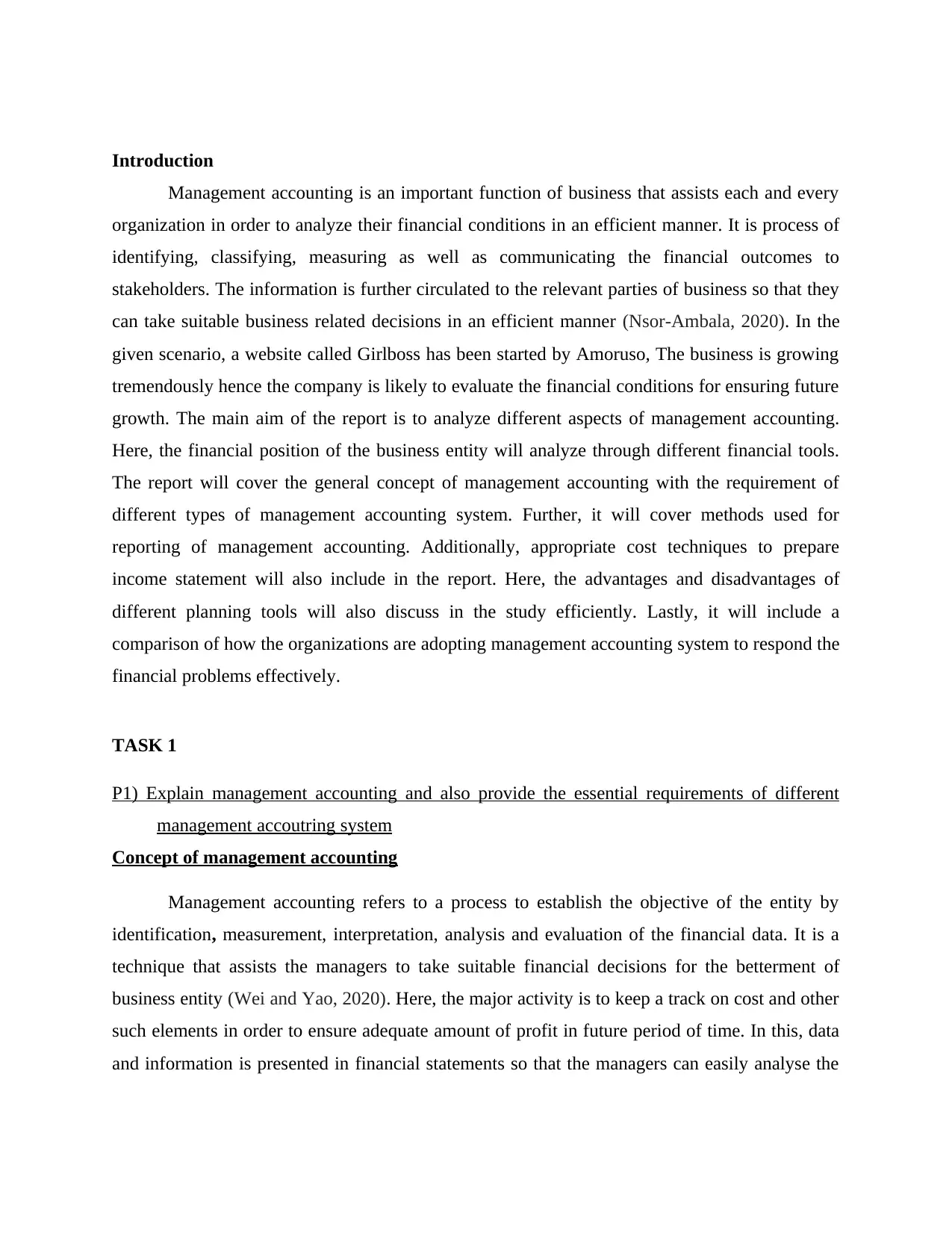
Introduction
Management accounting is an important function of business that assists each and every
organization in order to analyze their financial conditions in an efficient manner. It is process of
identifying, classifying, measuring as well as communicating the financial outcomes to
stakeholders. The information is further circulated to the relevant parties of business so that they
can take suitable business related decisions in an efficient manner (Nsor-Ambala, 2020). In the
given scenario, a website called Girlboss has been started by Amoruso, The business is growing
tremendously hence the company is likely to evaluate the financial conditions for ensuring future
growth. The main aim of the report is to analyze different aspects of management accounting.
Here, the financial position of the business entity will analyze through different financial tools.
The report will cover the general concept of management accounting with the requirement of
different types of management accounting system. Further, it will cover methods used for
reporting of management accounting. Additionally, appropriate cost techniques to prepare
income statement will also include in the report. Here, the advantages and disadvantages of
different planning tools will also discuss in the study efficiently. Lastly, it will include a
comparison of how the organizations are adopting management accounting system to respond the
financial problems effectively.
TASK 1
P1) Explain management accounting and also provide the essential requirements of different
management accoutring system
Concept of management accounting
Management accounting refers to a process to establish the objective of the entity by
identification, measurement, interpretation, analysis and evaluation of the financial data. It is a
technique that assists the managers to take suitable financial decisions for the betterment of
business entity (Wei and Yao, 2020). Here, the major activity is to keep a track on cost and other
such elements in order to ensure adequate amount of profit in future period of time. In this, data
and information is presented in financial statements so that the managers can easily analyse the
Management accounting is an important function of business that assists each and every
organization in order to analyze their financial conditions in an efficient manner. It is process of
identifying, classifying, measuring as well as communicating the financial outcomes to
stakeholders. The information is further circulated to the relevant parties of business so that they
can take suitable business related decisions in an efficient manner (Nsor-Ambala, 2020). In the
given scenario, a website called Girlboss has been started by Amoruso, The business is growing
tremendously hence the company is likely to evaluate the financial conditions for ensuring future
growth. The main aim of the report is to analyze different aspects of management accounting.
Here, the financial position of the business entity will analyze through different financial tools.
The report will cover the general concept of management accounting with the requirement of
different types of management accounting system. Further, it will cover methods used for
reporting of management accounting. Additionally, appropriate cost techniques to prepare
income statement will also include in the report. Here, the advantages and disadvantages of
different planning tools will also discuss in the study efficiently. Lastly, it will include a
comparison of how the organizations are adopting management accounting system to respond the
financial problems effectively.
TASK 1
P1) Explain management accounting and also provide the essential requirements of different
management accoutring system
Concept of management accounting
Management accounting refers to a process to establish the objective of the entity by
identification, measurement, interpretation, analysis and evaluation of the financial data. It is a
technique that assists the managers to take suitable financial decisions for the betterment of
business entity (Wei and Yao, 2020). Here, the major activity is to keep a track on cost and other
such elements in order to ensure adequate amount of profit in future period of time. In this, data
and information is presented in financial statements so that the managers can easily analyse the
⊘ This is a preview!⊘
Do you want full access?
Subscribe today to unlock all pages.

Trusted by 1+ million students worldwide
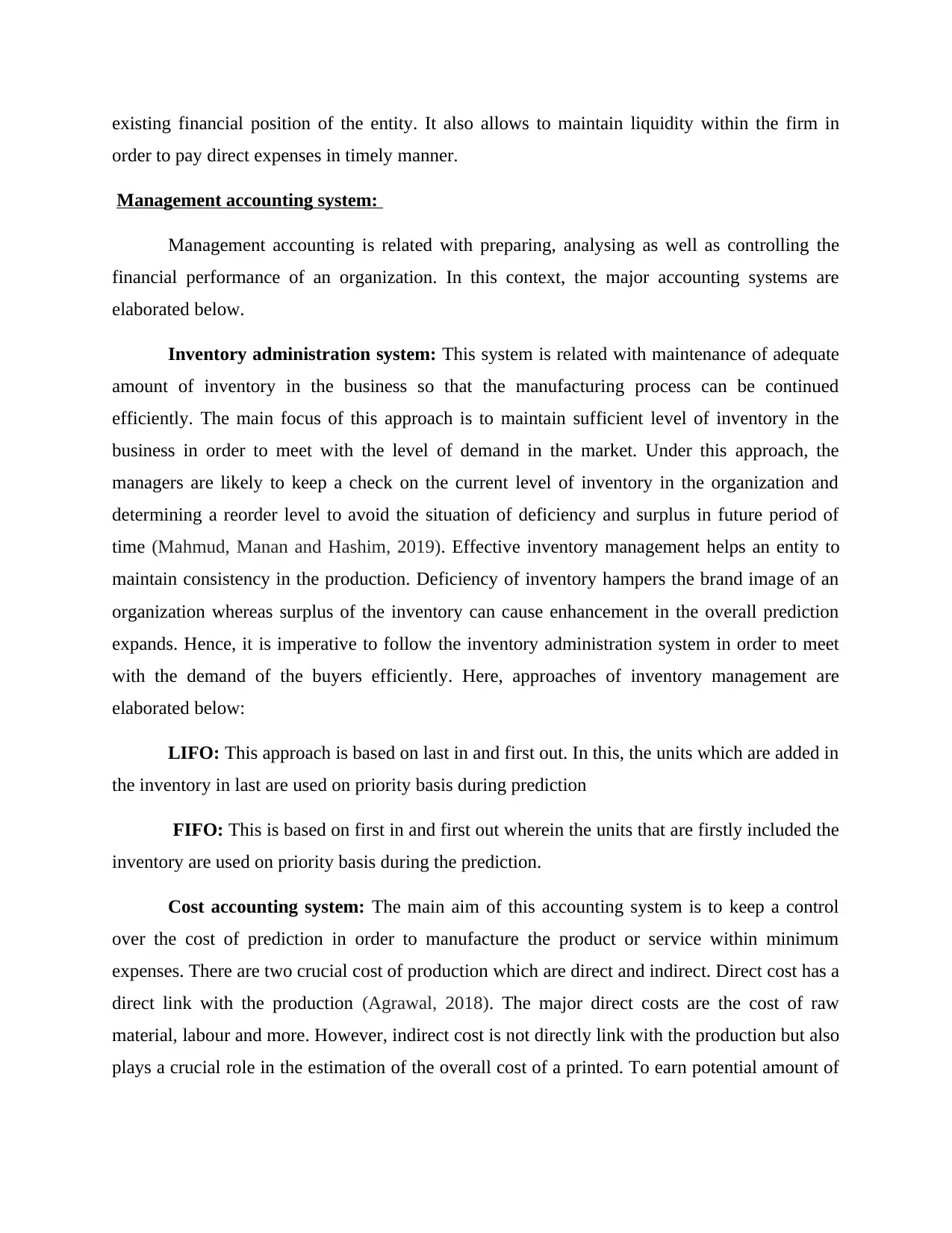
existing financial position of the entity. It also allows to maintain liquidity within the firm in
order to pay direct expenses in timely manner.
Management accounting system:
Management accounting is related with preparing, analysing as well as controlling the
financial performance of an organization. In this context, the major accounting systems are
elaborated below.
Inventory administration system: This system is related with maintenance of adequate
amount of inventory in the business so that the manufacturing process can be continued
efficiently. The main focus of this approach is to maintain sufficient level of inventory in the
business in order to meet with the level of demand in the market. Under this approach, the
managers are likely to keep a check on the current level of inventory in the organization and
determining a reorder level to avoid the situation of deficiency and surplus in future period of
time (Mahmud, Manan and Hashim, 2019). Effective inventory management helps an entity to
maintain consistency in the production. Deficiency of inventory hampers the brand image of an
organization whereas surplus of the inventory can cause enhancement in the overall prediction
expands. Hence, it is imperative to follow the inventory administration system in order to meet
with the demand of the buyers efficiently. Here, approaches of inventory management are
elaborated below:
LIFO: This approach is based on last in and first out. In this, the units which are added in
the inventory in last are used on priority basis during prediction
FIFO: This is based on first in and first out wherein the units that are firstly included the
inventory are used on priority basis during the prediction.
Cost accounting system: The main aim of this accounting system is to keep a control
over the cost of prediction in order to manufacture the product or service within minimum
expenses. There are two crucial cost of production which are direct and indirect. Direct cost has a
direct link with the production (Agrawal, 2018). The major direct costs are the cost of raw
material, labour and more. However, indirect cost is not directly link with the production but also
plays a crucial role in the estimation of the overall cost of a printed. To earn potential amount of
order to pay direct expenses in timely manner.
Management accounting system:
Management accounting is related with preparing, analysing as well as controlling the
financial performance of an organization. In this context, the major accounting systems are
elaborated below.
Inventory administration system: This system is related with maintenance of adequate
amount of inventory in the business so that the manufacturing process can be continued
efficiently. The main focus of this approach is to maintain sufficient level of inventory in the
business in order to meet with the level of demand in the market. Under this approach, the
managers are likely to keep a check on the current level of inventory in the organization and
determining a reorder level to avoid the situation of deficiency and surplus in future period of
time (Mahmud, Manan and Hashim, 2019). Effective inventory management helps an entity to
maintain consistency in the production. Deficiency of inventory hampers the brand image of an
organization whereas surplus of the inventory can cause enhancement in the overall prediction
expands. Hence, it is imperative to follow the inventory administration system in order to meet
with the demand of the buyers efficiently. Here, approaches of inventory management are
elaborated below:
LIFO: This approach is based on last in and first out. In this, the units which are added in
the inventory in last are used on priority basis during prediction
FIFO: This is based on first in and first out wherein the units that are firstly included the
inventory are used on priority basis during the prediction.
Cost accounting system: The main aim of this accounting system is to keep a control
over the cost of prediction in order to manufacture the product or service within minimum
expenses. There are two crucial cost of production which are direct and indirect. Direct cost has a
direct link with the production (Agrawal, 2018). The major direct costs are the cost of raw
material, labour and more. However, indirect cost is not directly link with the production but also
plays a crucial role in the estimation of the overall cost of a printed. To earn potential amount of
Paraphrase This Document
Need a fresh take? Get an instant paraphrase of this document with our AI Paraphraser
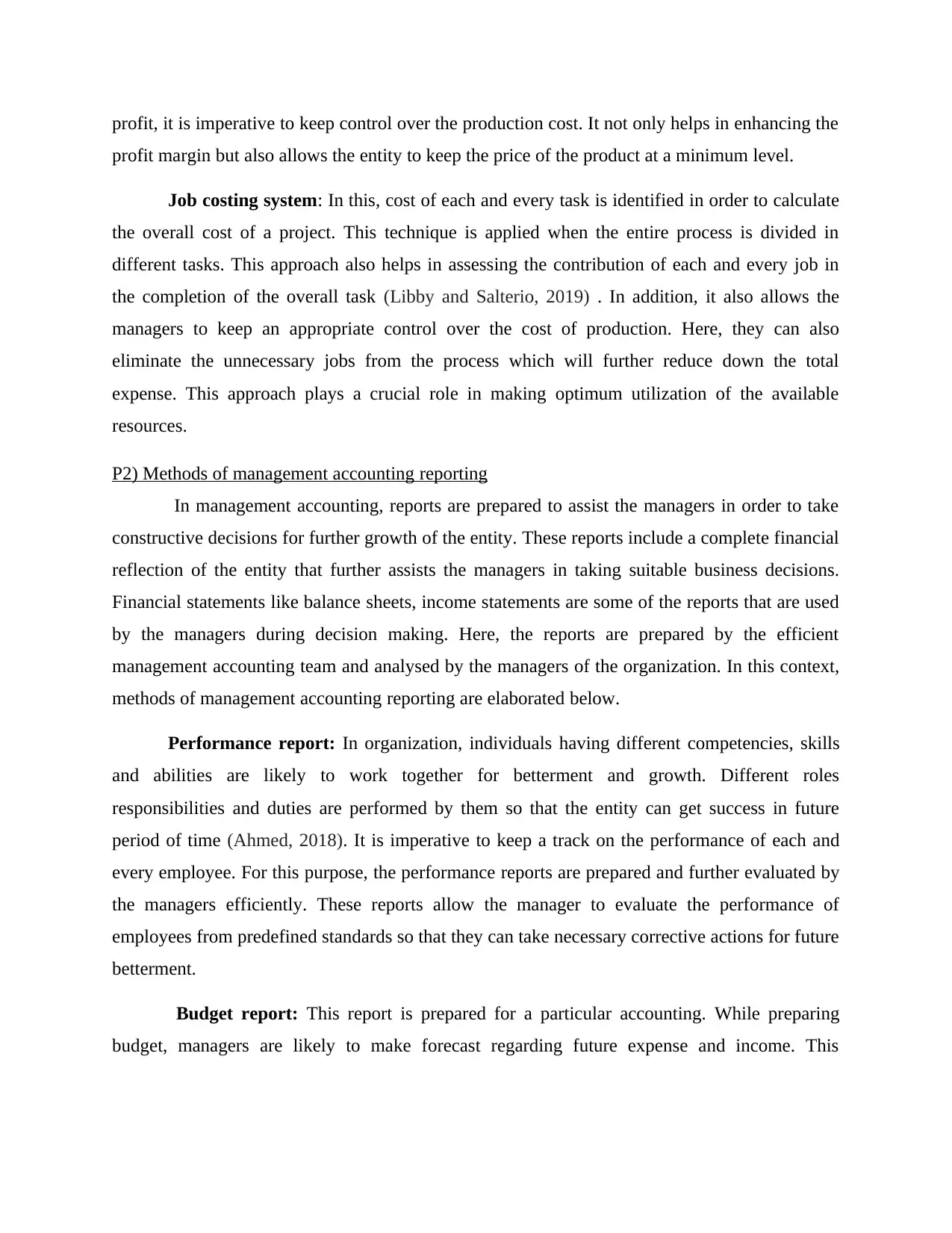
profit, it is imperative to keep control over the production cost. It not only helps in enhancing the
profit margin but also allows the entity to keep the price of the product at a minimum level.
Job costing system: In this, cost of each and every task is identified in order to calculate
the overall cost of a project. This technique is applied when the entire process is divided in
different tasks. This approach also helps in assessing the contribution of each and every job in
the completion of the overall task (Libby and Salterio, 2019) . In addition, it also allows the
managers to keep an appropriate control over the cost of production. Here, they can also
eliminate the unnecessary jobs from the process which will further reduce down the total
expense. This approach plays a crucial role in making optimum utilization of the available
resources.
P2) Methods of management accounting reporting
In management accounting, reports are prepared to assist the managers in order to take
constructive decisions for further growth of the entity. These reports include a complete financial
reflection of the entity that further assists the managers in taking suitable business decisions.
Financial statements like balance sheets, income statements are some of the reports that are used
by the managers during decision making. Here, the reports are prepared by the efficient
management accounting team and analysed by the managers of the organization. In this context,
methods of management accounting reporting are elaborated below.
Performance report: In organization, individuals having different competencies, skills
and abilities are likely to work together for betterment and growth. Different roles
responsibilities and duties are performed by them so that the entity can get success in future
period of time (Ahmed, 2018). It is imperative to keep a track on the performance of each and
every employee. For this purpose, the performance reports are prepared and further evaluated by
the managers efficiently. These reports allow the manager to evaluate the performance of
employees from predefined standards so that they can take necessary corrective actions for future
betterment.
Budget report: This report is prepared for a particular accounting. While preparing
budget, managers are likely to make forecast regarding future expense and income. This
profit margin but also allows the entity to keep the price of the product at a minimum level.
Job costing system: In this, cost of each and every task is identified in order to calculate
the overall cost of a project. This technique is applied when the entire process is divided in
different tasks. This approach also helps in assessing the contribution of each and every job in
the completion of the overall task (Libby and Salterio, 2019) . In addition, it also allows the
managers to keep an appropriate control over the cost of production. Here, they can also
eliminate the unnecessary jobs from the process which will further reduce down the total
expense. This approach plays a crucial role in making optimum utilization of the available
resources.
P2) Methods of management accounting reporting
In management accounting, reports are prepared to assist the managers in order to take
constructive decisions for further growth of the entity. These reports include a complete financial
reflection of the entity that further assists the managers in taking suitable business decisions.
Financial statements like balance sheets, income statements are some of the reports that are used
by the managers during decision making. Here, the reports are prepared by the efficient
management accounting team and analysed by the managers of the organization. In this context,
methods of management accounting reporting are elaborated below.
Performance report: In organization, individuals having different competencies, skills
and abilities are likely to work together for betterment and growth. Different roles
responsibilities and duties are performed by them so that the entity can get success in future
period of time (Ahmed, 2018). It is imperative to keep a track on the performance of each and
every employee. For this purpose, the performance reports are prepared and further evaluated by
the managers efficiently. These reports allow the manager to evaluate the performance of
employees from predefined standards so that they can take necessary corrective actions for future
betterment.
Budget report: This report is prepared for a particular accounting. While preparing
budget, managers are likely to make forecast regarding future expense and income. This
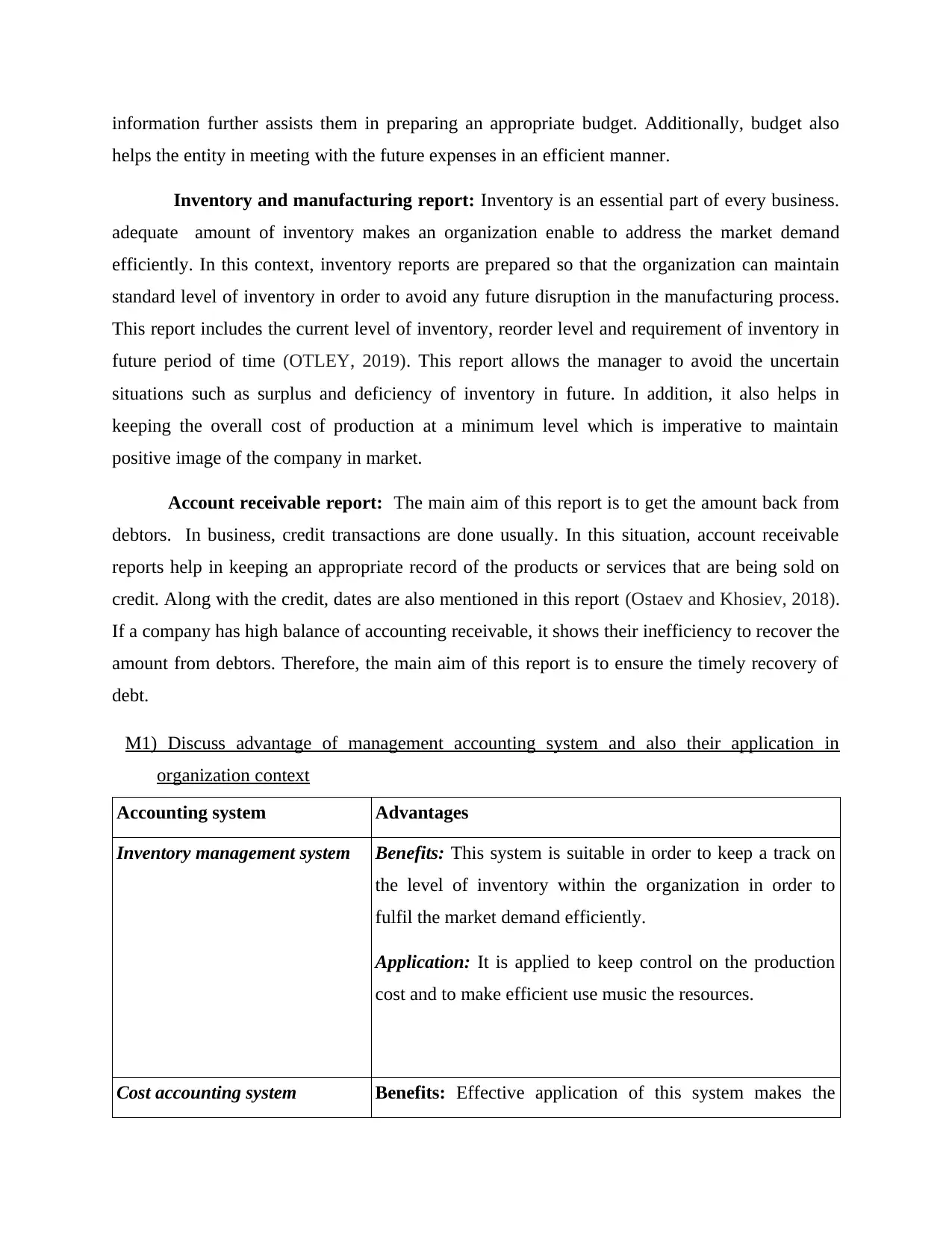
information further assists them in preparing an appropriate budget. Additionally, budget also
helps the entity in meeting with the future expenses in an efficient manner.
Inventory and manufacturing report: Inventory is an essential part of every business.
adequate amount of inventory makes an organization enable to address the market demand
efficiently. In this context, inventory reports are prepared so that the organization can maintain
standard level of inventory in order to avoid any future disruption in the manufacturing process.
This report includes the current level of inventory, reorder level and requirement of inventory in
future period of time (OTLEY, 2019). This report allows the manager to avoid the uncertain
situations such as surplus and deficiency of inventory in future. In addition, it also helps in
keeping the overall cost of production at a minimum level which is imperative to maintain
positive image of the company in market.
Account receivable report: The main aim of this report is to get the amount back from
debtors. In business, credit transactions are done usually. In this situation, account receivable
reports help in keeping an appropriate record of the products or services that are being sold on
credit. Along with the credit, dates are also mentioned in this report (Ostaev and Khosiev, 2018).
If a company has high balance of accounting receivable, it shows their inefficiency to recover the
amount from debtors. Therefore, the main aim of this report is to ensure the timely recovery of
debt.
M1) Discuss advantage of management accounting system and also their application in
organization context
Accounting system Advantages
Inventory management system Benefits: This system is suitable in order to keep a track on
the level of inventory within the organization in order to
fulfil the market demand efficiently.
Application: It is applied to keep control on the production
cost and to make efficient use music the resources.
Cost accounting system Benefits: Effective application of this system makes the
helps the entity in meeting with the future expenses in an efficient manner.
Inventory and manufacturing report: Inventory is an essential part of every business.
adequate amount of inventory makes an organization enable to address the market demand
efficiently. In this context, inventory reports are prepared so that the organization can maintain
standard level of inventory in order to avoid any future disruption in the manufacturing process.
This report includes the current level of inventory, reorder level and requirement of inventory in
future period of time (OTLEY, 2019). This report allows the manager to avoid the uncertain
situations such as surplus and deficiency of inventory in future. In addition, it also helps in
keeping the overall cost of production at a minimum level which is imperative to maintain
positive image of the company in market.
Account receivable report: The main aim of this report is to get the amount back from
debtors. In business, credit transactions are done usually. In this situation, account receivable
reports help in keeping an appropriate record of the products or services that are being sold on
credit. Along with the credit, dates are also mentioned in this report (Ostaev and Khosiev, 2018).
If a company has high balance of accounting receivable, it shows their inefficiency to recover the
amount from debtors. Therefore, the main aim of this report is to ensure the timely recovery of
debt.
M1) Discuss advantage of management accounting system and also their application in
organization context
Accounting system Advantages
Inventory management system Benefits: This system is suitable in order to keep a track on
the level of inventory within the organization in order to
fulfil the market demand efficiently.
Application: It is applied to keep control on the production
cost and to make efficient use music the resources.
Cost accounting system Benefits: Effective application of this system makes the
⊘ This is a preview!⊘
Do you want full access?
Subscribe today to unlock all pages.

Trusted by 1+ million students worldwide
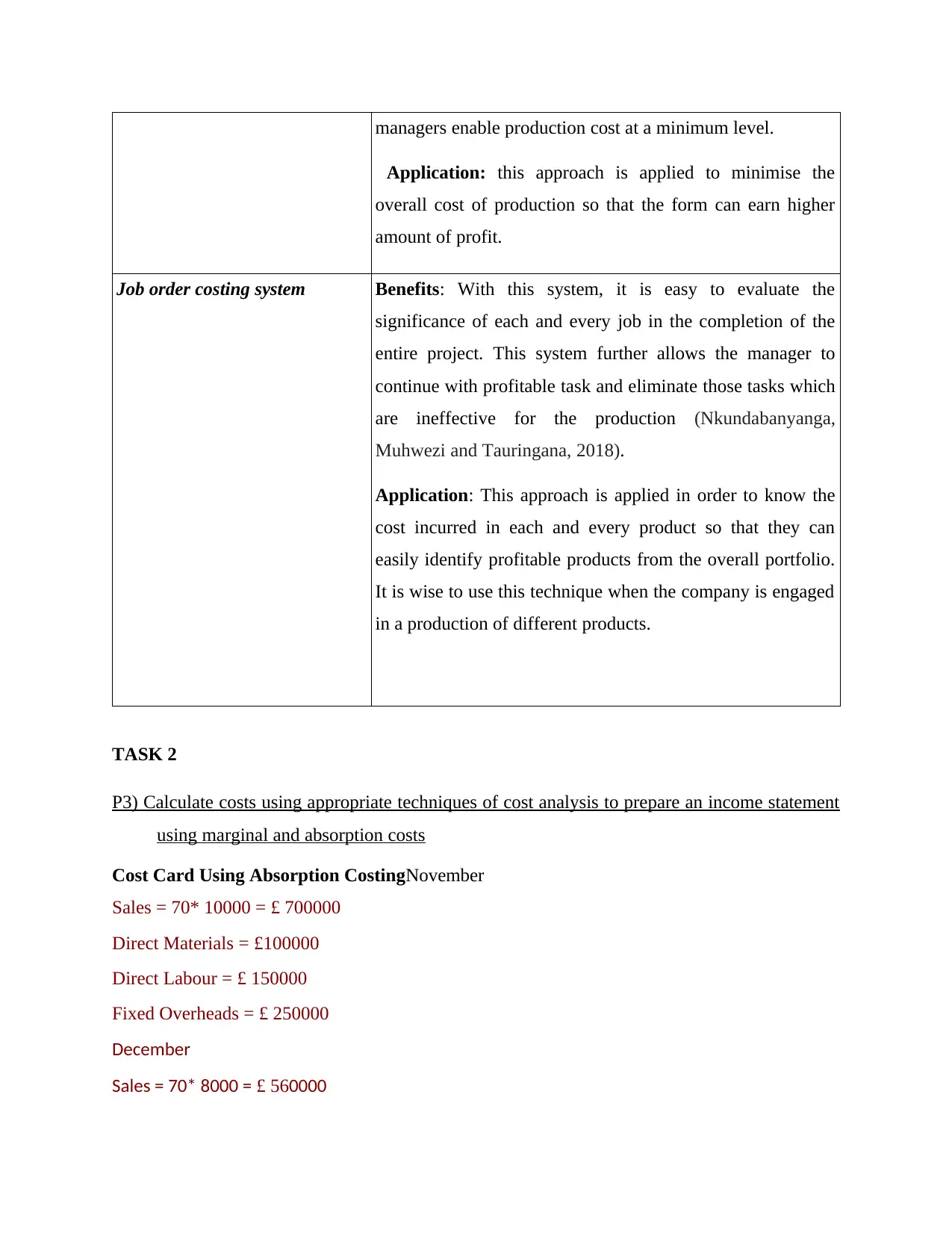
managers enable production cost at a minimum level.
Application: this approach is applied to minimise the
overall cost of production so that the form can earn higher
amount of profit.
Job order costing system Benefits: With this system, it is easy to evaluate the
significance of each and every job in the completion of the
entire project. This system further allows the manager to
continue with profitable task and eliminate those tasks which
are ineffective for the production (Nkundabanyanga,
Muhwezi and Tauringana, 2018).
Application: This approach is applied in order to know the
cost incurred in each and every product so that they can
easily identify profitable products from the overall portfolio.
It is wise to use this technique when the company is engaged
in a production of different products.
TASK 2
P3) Calculate costs using appropriate techniques of cost analysis to prepare an income statement
using marginal and absorption costs
Cost Card Using Absorption CostingNovember
Sales = 70* 10000 = £ 700000
Direct Materials = £100000
Direct Labour = £ 150000
Fixed Overheads = £ 250000
December
Sales = 70* 8000 = £ 560000
Application: this approach is applied to minimise the
overall cost of production so that the form can earn higher
amount of profit.
Job order costing system Benefits: With this system, it is easy to evaluate the
significance of each and every job in the completion of the
entire project. This system further allows the manager to
continue with profitable task and eliminate those tasks which
are ineffective for the production (Nkundabanyanga,
Muhwezi and Tauringana, 2018).
Application: This approach is applied in order to know the
cost incurred in each and every product so that they can
easily identify profitable products from the overall portfolio.
It is wise to use this technique when the company is engaged
in a production of different products.
TASK 2
P3) Calculate costs using appropriate techniques of cost analysis to prepare an income statement
using marginal and absorption costs
Cost Card Using Absorption CostingNovember
Sales = 70* 10000 = £ 700000
Direct Materials = £100000
Direct Labour = £ 150000
Fixed Overheads = £ 250000
December
Sales = 70* 8000 = £ 560000
Paraphrase This Document
Need a fresh take? Get an instant paraphrase of this document with our AI Paraphraser
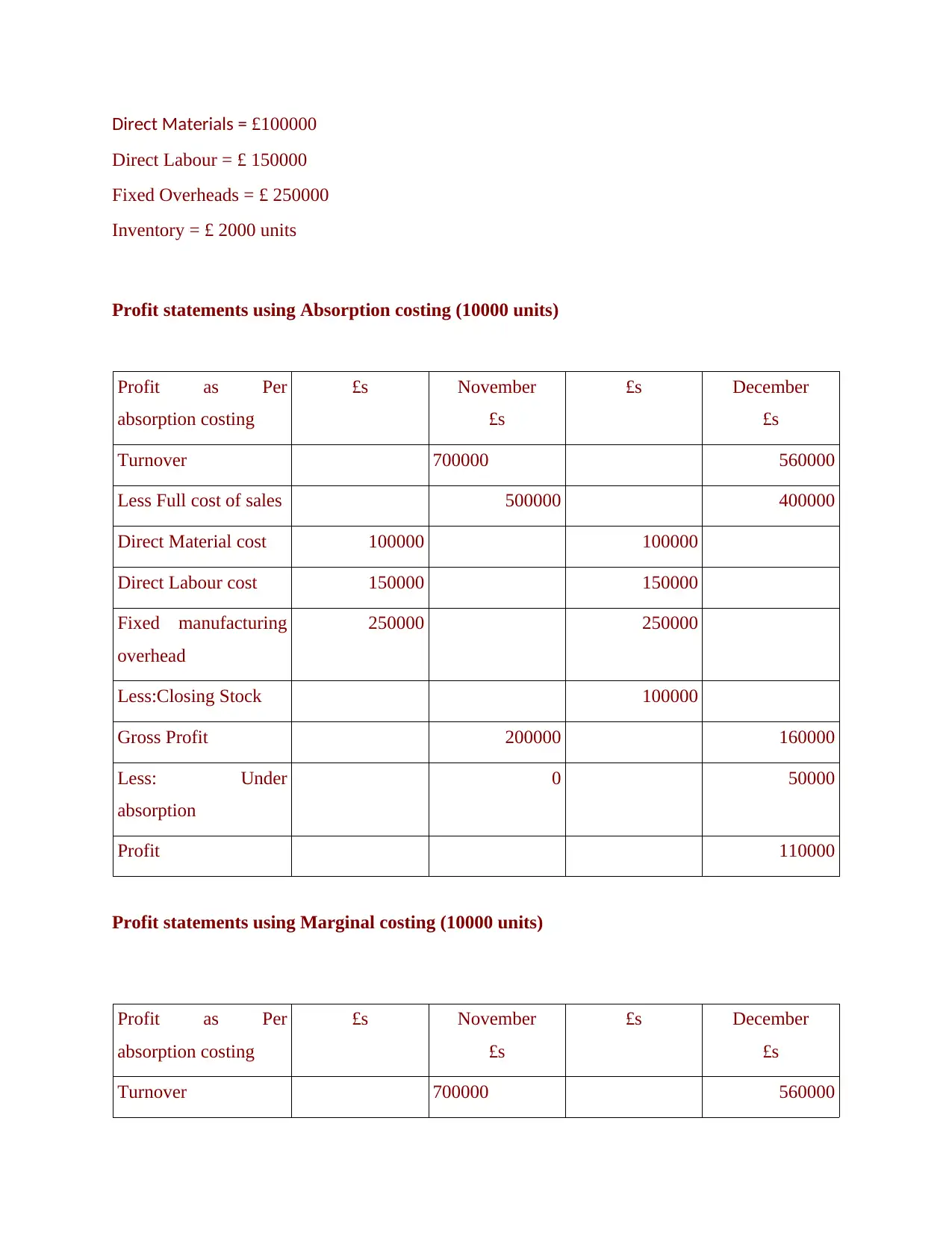
Direct Materials = £100000
Direct Labour = £ 150000
Fixed Overheads = £ 250000
Inventory = £ 2000 units
Profit statements using Absorption costing (10000 units)
Profit as Per
absorption costing
£s November
£s
£s December
£s
Turnover 700000 560000
Less Full cost of sales 500000 400000
Direct Material cost 100000 100000
Direct Labour cost 150000 150000
Fixed manufacturing
overhead
250000 250000
Less:Closing Stock 100000
Gross Profit 200000 160000
Less: Under
absorption
0 50000
Profit 110000
Profit statements using Marginal costing (10000 units)
Profit as Per
absorption costing
£s November
£s
£s December
£s
Turnover 700000 560000
Direct Labour = £ 150000
Fixed Overheads = £ 250000
Inventory = £ 2000 units
Profit statements using Absorption costing (10000 units)
Profit as Per
absorption costing
£s November
£s
£s December
£s
Turnover 700000 560000
Less Full cost of sales 500000 400000
Direct Material cost 100000 100000
Direct Labour cost 150000 150000
Fixed manufacturing
overhead
250000 250000
Less:Closing Stock 100000
Gross Profit 200000 160000
Less: Under
absorption
0 50000
Profit 110000
Profit statements using Marginal costing (10000 units)
Profit as Per
absorption costing
£s November
£s
£s December
£s
Turnover 700000 560000
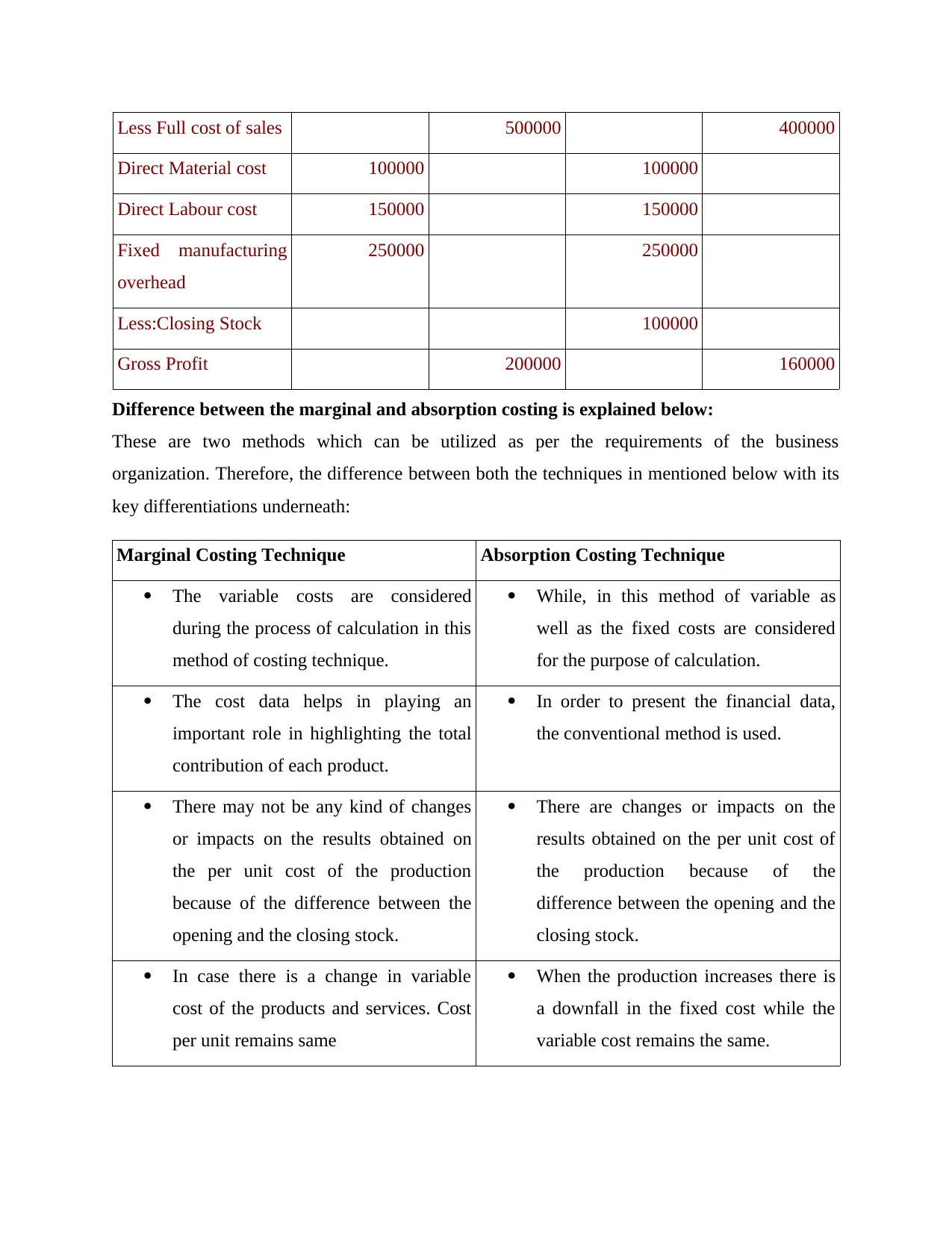
Less Full cost of sales 500000 400000
Direct Material cost 100000 100000
Direct Labour cost 150000 150000
Fixed manufacturing
overhead
250000 250000
Less:Closing Stock 100000
Gross Profit 200000 160000
Difference between the marginal and absorption costing is explained below:
These are two methods which can be utilized as per the requirements of the business
organization. Therefore, the difference between both the techniques in mentioned below with its
key differentiations underneath:
Marginal Costing Technique Absorption Costing Technique
The variable costs are considered
during the process of calculation in this
method of costing technique.
While, in this method of variable as
well as the fixed costs are considered
for the purpose of calculation.
The cost data helps in playing an
important role in highlighting the total
contribution of each product.
In order to present the financial data,
the conventional method is used.
There may not be any kind of changes
or impacts on the results obtained on
the per unit cost of the production
because of the difference between the
opening and the closing stock.
There are changes or impacts on the
results obtained on the per unit cost of
the production because of the
difference between the opening and the
closing stock.
In case there is a change in variable
cost of the products and services. Cost
per unit remains same
When the production increases there is
a downfall in the fixed cost while the
variable cost remains the same.
Direct Material cost 100000 100000
Direct Labour cost 150000 150000
Fixed manufacturing
overhead
250000 250000
Less:Closing Stock 100000
Gross Profit 200000 160000
Difference between the marginal and absorption costing is explained below:
These are two methods which can be utilized as per the requirements of the business
organization. Therefore, the difference between both the techniques in mentioned below with its
key differentiations underneath:
Marginal Costing Technique Absorption Costing Technique
The variable costs are considered
during the process of calculation in this
method of costing technique.
While, in this method of variable as
well as the fixed costs are considered
for the purpose of calculation.
The cost data helps in playing an
important role in highlighting the total
contribution of each product.
In order to present the financial data,
the conventional method is used.
There may not be any kind of changes
or impacts on the results obtained on
the per unit cost of the production
because of the difference between the
opening and the closing stock.
There are changes or impacts on the
results obtained on the per unit cost of
the production because of the
difference between the opening and the
closing stock.
In case there is a change in variable
cost of the products and services. Cost
per unit remains same
When the production increases there is
a downfall in the fixed cost while the
variable cost remains the same.
⊘ This is a preview!⊘
Do you want full access?
Subscribe today to unlock all pages.

Trusted by 1+ million students worldwide
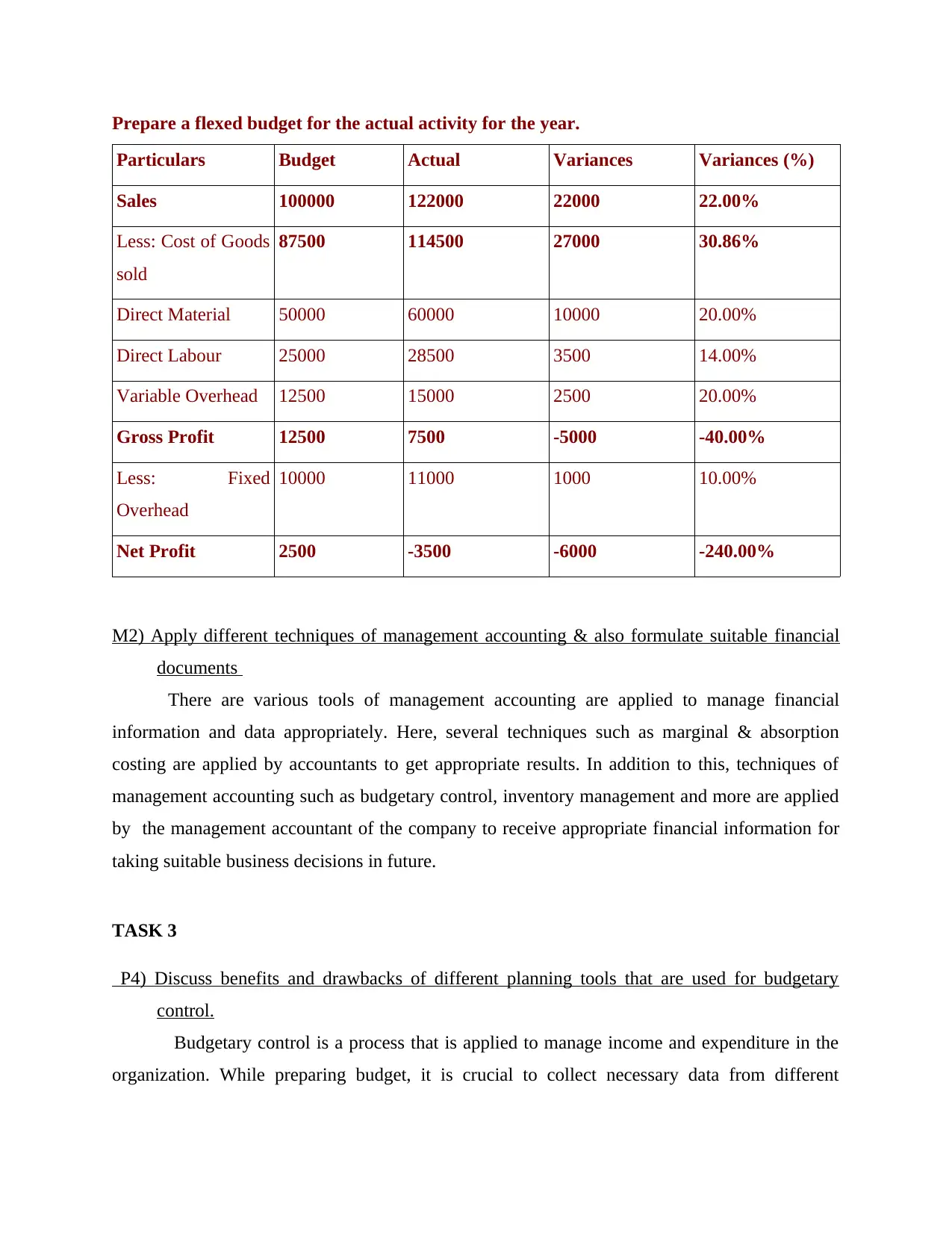
Prepare a flexed budget for the actual activity for the year.
Particulars Budget Actual Variances Variances (%)
Sales 100000 122000 22000 22.00%
Less: Cost of Goods
sold
87500 114500 27000 30.86%
Direct Material 50000 60000 10000 20.00%
Direct Labour 25000 28500 3500 14.00%
Variable Overhead 12500 15000 2500 20.00%
Gross Profit 12500 7500 -5000 -40.00%
Less: Fixed
Overhead
10000 11000 1000 10.00%
Net Profit 2500 -3500 -6000 -240.00%
M2) Apply different techniques of management accounting & also formulate suitable financial
documents
There are various tools of management accounting are applied to manage financial
information and data appropriately. Here, several techniques such as marginal & absorption
costing are applied by accountants to get appropriate results. In addition to this, techniques of
management accounting such as budgetary control, inventory management and more are applied
by the management accountant of the company to receive appropriate financial information for
taking suitable business decisions in future.
TASK 3
P4) Discuss benefits and drawbacks of different planning tools that are used for budgetary
control.
Budgetary control is a process that is applied to manage income and expenditure in the
organization. While preparing budget, it is crucial to collect necessary data from different
Particulars Budget Actual Variances Variances (%)
Sales 100000 122000 22000 22.00%
Less: Cost of Goods
sold
87500 114500 27000 30.86%
Direct Material 50000 60000 10000 20.00%
Direct Labour 25000 28500 3500 14.00%
Variable Overhead 12500 15000 2500 20.00%
Gross Profit 12500 7500 -5000 -40.00%
Less: Fixed
Overhead
10000 11000 1000 10.00%
Net Profit 2500 -3500 -6000 -240.00%
M2) Apply different techniques of management accounting & also formulate suitable financial
documents
There are various tools of management accounting are applied to manage financial
information and data appropriately. Here, several techniques such as marginal & absorption
costing are applied by accountants to get appropriate results. In addition to this, techniques of
management accounting such as budgetary control, inventory management and more are applied
by the management accountant of the company to receive appropriate financial information for
taking suitable business decisions in future.
TASK 3
P4) Discuss benefits and drawbacks of different planning tools that are used for budgetary
control.
Budgetary control is a process that is applied to manage income and expenditure in the
organization. While preparing budget, it is crucial to collect necessary data from different
Paraphrase This Document
Need a fresh take? Get an instant paraphrase of this document with our AI Paraphraser
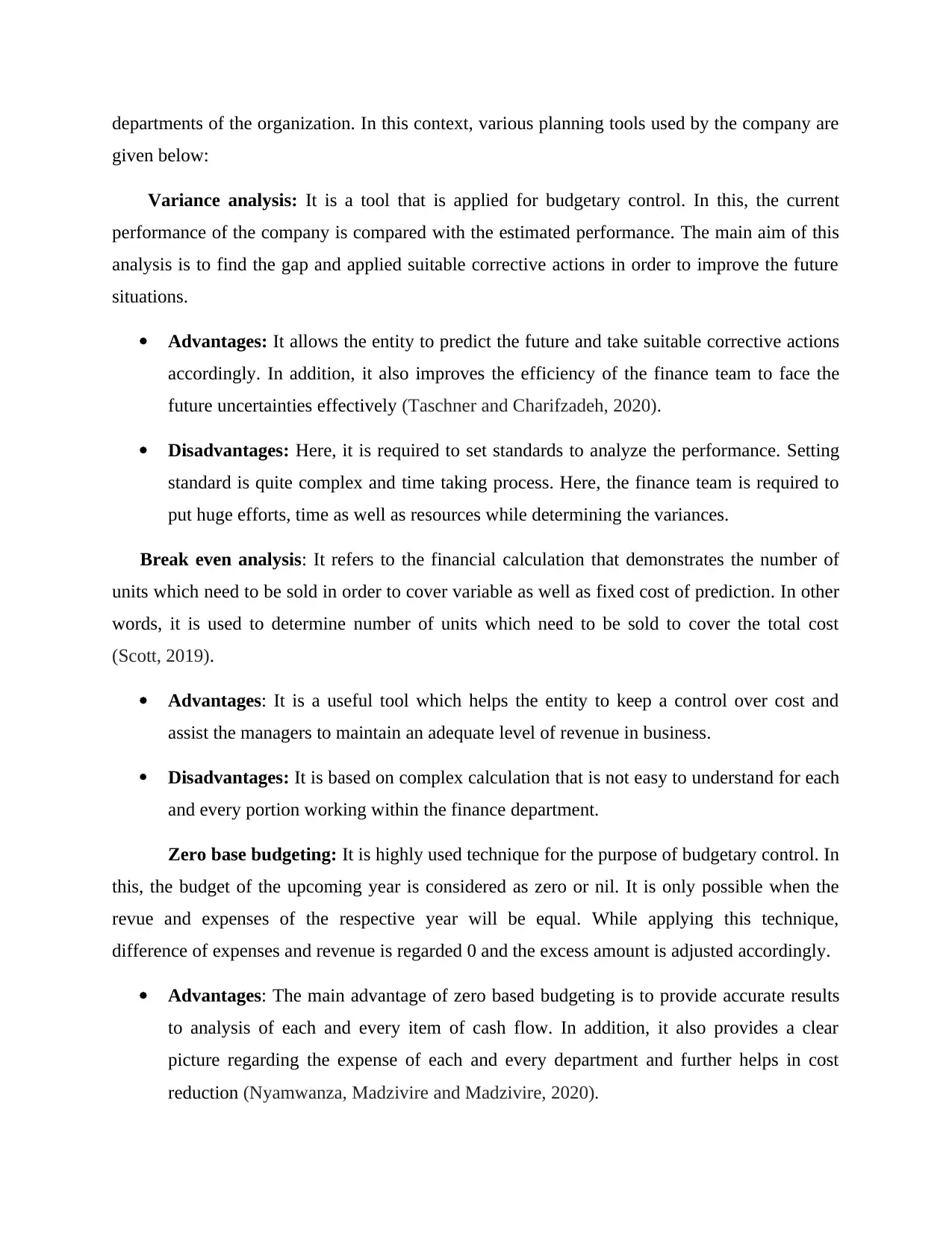
departments of the organization. In this context, various planning tools used by the company are
given below:
Variance analysis: It is a tool that is applied for budgetary control. In this, the current
performance of the company is compared with the estimated performance. The main aim of this
analysis is to find the gap and applied suitable corrective actions in order to improve the future
situations.
Advantages: It allows the entity to predict the future and take suitable corrective actions
accordingly. In addition, it also improves the efficiency of the finance team to face the
future uncertainties effectively (Taschner and Charifzadeh, 2020).
Disadvantages: Here, it is required to set standards to analyze the performance. Setting
standard is quite complex and time taking process. Here, the finance team is required to
put huge efforts, time as well as resources while determining the variances.
Break even analysis: It refers to the financial calculation that demonstrates the number of
units which need to be sold in order to cover variable as well as fixed cost of prediction. In other
words, it is used to determine number of units which need to be sold to cover the total cost
(Scott, 2019).
Advantages: It is a useful tool which helps the entity to keep a control over cost and
assist the managers to maintain an adequate level of revenue in business.
Disadvantages: It is based on complex calculation that is not easy to understand for each
and every portion working within the finance department.
Zero base budgeting: It is highly used technique for the purpose of budgetary control. In
this, the budget of the upcoming year is considered as zero or nil. It is only possible when the
revue and expenses of the respective year will be equal. While applying this technique,
difference of expenses and revenue is regarded 0 and the excess amount is adjusted accordingly.
Advantages: The main advantage of zero based budgeting is to provide accurate results
to analysis of each and every item of cash flow. In addition, it also provides a clear
picture regarding the expense of each and every department and further helps in cost
reduction (Nyamwanza, Madzivire and Madzivire, 2020).
given below:
Variance analysis: It is a tool that is applied for budgetary control. In this, the current
performance of the company is compared with the estimated performance. The main aim of this
analysis is to find the gap and applied suitable corrective actions in order to improve the future
situations.
Advantages: It allows the entity to predict the future and take suitable corrective actions
accordingly. In addition, it also improves the efficiency of the finance team to face the
future uncertainties effectively (Taschner and Charifzadeh, 2020).
Disadvantages: Here, it is required to set standards to analyze the performance. Setting
standard is quite complex and time taking process. Here, the finance team is required to
put huge efforts, time as well as resources while determining the variances.
Break even analysis: It refers to the financial calculation that demonstrates the number of
units which need to be sold in order to cover variable as well as fixed cost of prediction. In other
words, it is used to determine number of units which need to be sold to cover the total cost
(Scott, 2019).
Advantages: It is a useful tool which helps the entity to keep a control over cost and
assist the managers to maintain an adequate level of revenue in business.
Disadvantages: It is based on complex calculation that is not easy to understand for each
and every portion working within the finance department.
Zero base budgeting: It is highly used technique for the purpose of budgetary control. In
this, the budget of the upcoming year is considered as zero or nil. It is only possible when the
revue and expenses of the respective year will be equal. While applying this technique,
difference of expenses and revenue is regarded 0 and the excess amount is adjusted accordingly.
Advantages: The main advantage of zero based budgeting is to provide accurate results
to analysis of each and every item of cash flow. In addition, it also provides a clear
picture regarding the expense of each and every department and further helps in cost
reduction (Nyamwanza, Madzivire and Madzivire, 2020).
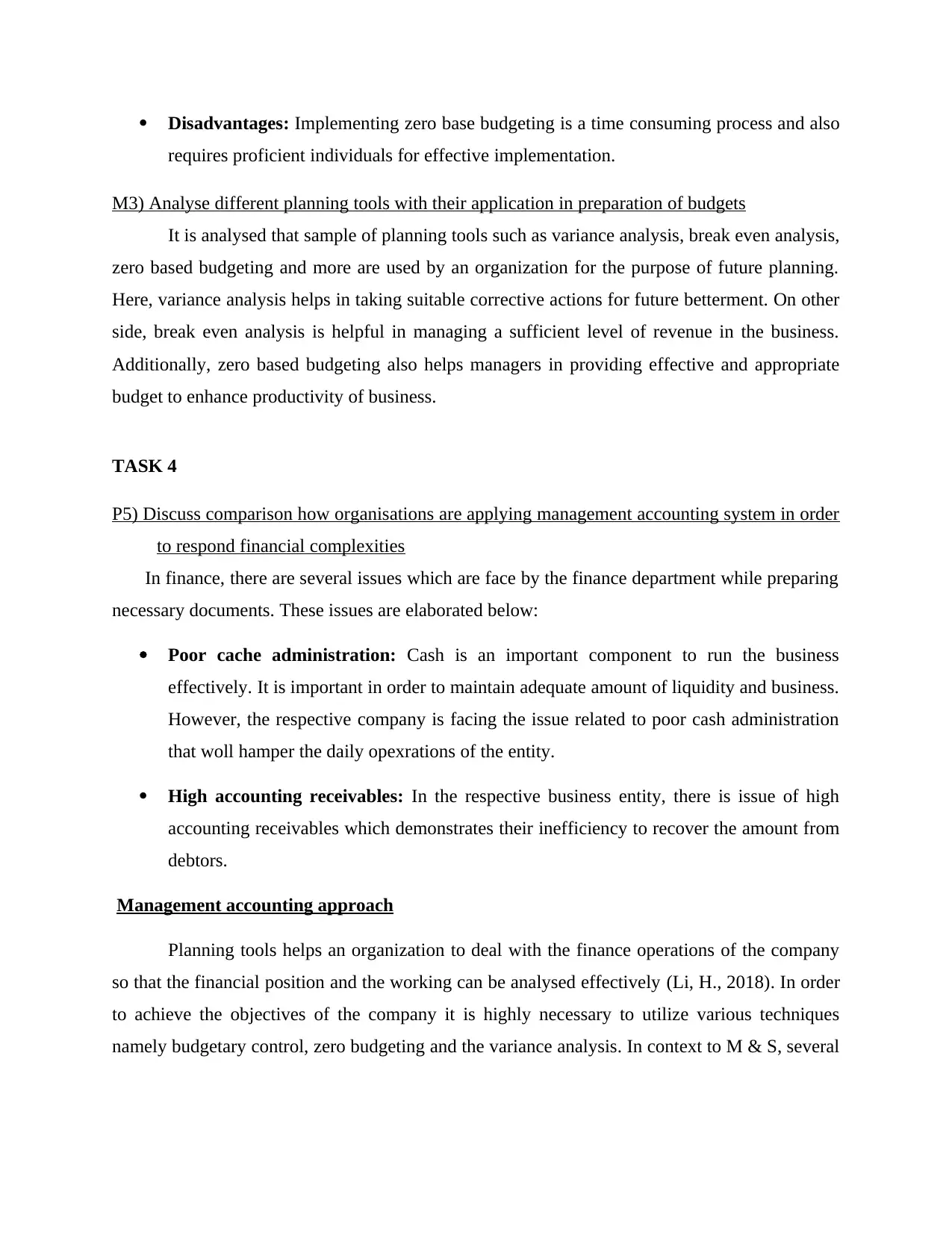
Disadvantages: Implementing zero base budgeting is a time consuming process and also
requires proficient individuals for effective implementation.
M3) Analyse different planning tools with their application in preparation of budgets
It is analysed that sample of planning tools such as variance analysis, break even analysis,
zero based budgeting and more are used by an organization for the purpose of future planning.
Here, variance analysis helps in taking suitable corrective actions for future betterment. On other
side, break even analysis is helpful in managing a sufficient level of revenue in the business.
Additionally, zero based budgeting also helps managers in providing effective and appropriate
budget to enhance productivity of business.
TASK 4
P5) Discuss comparison how organisations are applying management accounting system in order
to respond financial complexities
In finance, there are several issues which are face by the finance department while preparing
necessary documents. These issues are elaborated below:
Poor cache administration: Cash is an important component to run the business
effectively. It is important in order to maintain adequate amount of liquidity and business.
However, the respective company is facing the issue related to poor cash administration
that woll hamper the daily opexrations of the entity.
High accounting receivables: In the respective business entity, there is issue of high
accounting receivables which demonstrates their inefficiency to recover the amount from
debtors.
Management accounting approach
Planning tools helps an organization to deal with the finance operations of the company
so that the financial position and the working can be analysed effectively (Li, H., 2018). In order
to achieve the objectives of the company it is highly necessary to utilize various techniques
namely budgetary control, zero budgeting and the variance analysis. In context to M & S, several
requires proficient individuals for effective implementation.
M3) Analyse different planning tools with their application in preparation of budgets
It is analysed that sample of planning tools such as variance analysis, break even analysis,
zero based budgeting and more are used by an organization for the purpose of future planning.
Here, variance analysis helps in taking suitable corrective actions for future betterment. On other
side, break even analysis is helpful in managing a sufficient level of revenue in the business.
Additionally, zero based budgeting also helps managers in providing effective and appropriate
budget to enhance productivity of business.
TASK 4
P5) Discuss comparison how organisations are applying management accounting system in order
to respond financial complexities
In finance, there are several issues which are face by the finance department while preparing
necessary documents. These issues are elaborated below:
Poor cache administration: Cash is an important component to run the business
effectively. It is important in order to maintain adequate amount of liquidity and business.
However, the respective company is facing the issue related to poor cash administration
that woll hamper the daily opexrations of the entity.
High accounting receivables: In the respective business entity, there is issue of high
accounting receivables which demonstrates their inefficiency to recover the amount from
debtors.
Management accounting approach
Planning tools helps an organization to deal with the finance operations of the company
so that the financial position and the working can be analysed effectively (Li, H., 2018). In order
to achieve the objectives of the company it is highly necessary to utilize various techniques
namely budgetary control, zero budgeting and the variance analysis. In context to M & S, several
⊘ This is a preview!⊘
Do you want full access?
Subscribe today to unlock all pages.

Trusted by 1+ million students worldwide
1 out of 18
Related Documents
Your All-in-One AI-Powered Toolkit for Academic Success.
+13062052269
info@desklib.com
Available 24*7 on WhatsApp / Email
![[object Object]](/_next/static/media/star-bottom.7253800d.svg)
Unlock your academic potential
Copyright © 2020–2025 A2Z Services. All Rights Reserved. Developed and managed by ZUCOL.




